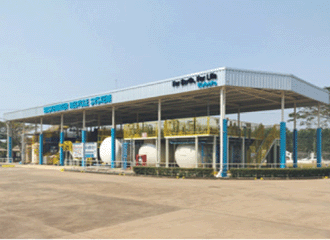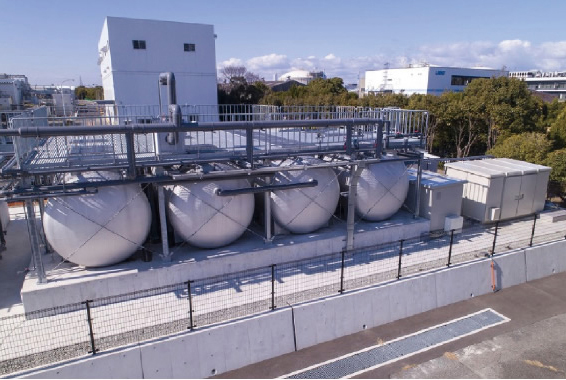Conserving Water Resources
The OECD's 2012 report entitled Environmental Outlook to 2050 states that during the period between 2000 and 2050, global demand for water will increase by approximately 55% owing to economic development and population increase, while more than 40% of the world's population will be living in river basins that suffer from severe water shortages.
The Kubota Group sees conserving water resources as one of its materiality issues, and has been advancing initiatives to promote the effective utilization of water resources and to address water risks, such as the reduction of water consumption by promoting water saving and wastewater recycling, and the proper management of wastewater treatment and wastewater quality. Production sites promote measures not to cause adverse effects on local ecosystems and the lives of local residents, taking into consideration the status of water stress in the respective regions.
- 【ESG Report】Conserving water Resources
- Medium- and Long-Term Environmental Conservation Targets and Results
Activities towards achieving SDGs
| Related SDGs and targets |
 |
|---|---|
| Major Activity Content |
|
| 2025 Activity Targets (KPIs) |
|
Measures to Reduce Water Withdrawal
The Kubota Group has established the Medium-Term Environmental Conservation Targets and is working to reduce water withdrawal at production sites. Our production sites, such as those in China, Thailand, Indonesia and the United States, have introduced wastewater treatment facilities or wastewater recycling systems utilizing technologies of the Kubota Group.
-

Kubota Engine (Thailand) Co., Ltd. has added additional capacity to its wastewater treatment system with the use of a membrane bioreactor (MBR). Recycled water is being used to water the gardens around the plant and as domestic water.
Water Management
The Kubota Group is committed to understanding, managing, and conserving water use at all of its 195 companies. Every year, our production sites draw up and revise a management plan for reducing the amount of water withdrawal, based on the Group’s Medium-Term Environmental Conservation Targets. Measures are also being taken at all 72 production sites to thoroughly manage water quality and prevent environmental accidents.
[Summary of water management in environment-related rules and regulations]
- An environmental management system shall be established at all sites to systematically promote environmental conservation activities.
- A monitoring system for environmental conservation shall be developed at all sites so as to periodically carry out examinations and inspections.
- The amount of water (service water, industrial water, groundwater, and recycled water) used and discharged at all sites in the course of business activities shall be assessed.
- Efforts shall be made to reduce the amount of water resources used at all sites. Also, a plan to reduce water withdrawal at all production sites shall be formulated, tracked, and revised every year.
- Water quality-related equipment shall be thoroughly managed (ensuring water treatment capacity, complying with design/ management standards, maintenance/operation) at all production sites, while environmental pollution risks associated with such equipment shall be mitigated and environmental accidents prevented from occurring.
| Envisaged scenario | Impact on the Group | Time horizon* | ||||
|---|---|---|---|---|---|---|
| Short term |
Medium term |
Long term |
||||
| Conserving Water Resources |
Risks |
|
Fines and shutdowns Lower social credibility Increase in regulatory compliance cost |
→ | → | → |
|
Increase in manufacturing costs | → | → | → | ||
|
Negative impact on the Group and its suppliers | → | → | → | ||
|
Loss of selling opportunities | → | → | |||
|
Increase in product development and manufacturing costs | → | → | |||
| Opportunities |
|
Expansion of selling opportunities | → | → | → | |
|
Increase in productivity | → | → | → | ||
|
Expansion in business related to adapting to climate change | → | → | → | ||
- Timing of manifestation is presented as short term (within three years), medium term (between three and five years), and long term (more than five years).
Environmental Conservation Costs
(Unit: million yen)
| Classifications | Main costs | FY2023 | FY2024 | |||
|---|---|---|---|---|---|---|
| Investment | Costs | Investment | Costs | |||
| Within the business area cost | 1,038 | 3,146 | 2,067 | 3,577 | ||
| Local environmental conservation cost | Cost of preventing air and water pollution, soil contamination, noise, and vibration. | 313 | 645 | 643 | 648 | |
| Global environmental conservation cost | Prevention of climate change, etc. | 720 | 1,224 | 1,424 | 1,195 | |
| Resource recycling cost | Cost of treating, disposing, reducing, minimizing, and recycling waste, as well as efficiently utilizing resources. | 5 | 1,277 | 0.2 | 1,734 | |
| Upstream and downstream costs | Collection of used products and commercialization of recycled products. | 0 | 25 | 0 | 40 | |
| Management activities cost | Environmental management personnel, ISO maintenance and implementation, environmental information dissemination. | 8 | 2,032 | 5 | 2,262 | |
| R&D cost | R&D for reduction of product environmental load and develoing environment conservation equipment. | 2,136 | 15,233 | 1,609 | 19,007 | |
| Farm & Industrial Machine | 641 | 8,990 | 784 | 11,546 | ||
| Water & Environment | 641 | 3,432 | 531 | 4,472 | ||
| Common | 854 | 2,811 | 294 | 2,989 | ||
| Social activities cost | Local cleanup activities, and membership fees and contributions to environmental. | 0 | 1 | 0 | 1 | |
| Environmental remediation cost | Local cleanup activities, and membership fees and contributions to environmental | 0 | 88 | 0 | 92 | |
| Total | 3,182 | 20,524 | 3,681 | 24,978 | ||
Controlling Water Discharge and Mitigating Water Risks
The Kubota Group has set its own control values that are stricter than the emission standards of relevant laws and regulations. To ensure that the standard values are not exceeded, the Kubota Group carries out regular measurement of designated monitoring items. Under the Medium-Term Environmental Conservation Targets 2025, the Group has established a new target of managing water discharge appropriately in line with standards for the areas where wastewater is released by operating wastewater treatment and water recycling facilities.
-

Kubota Sakai Rinkai Plant (Japan)
Submerged-type FRP johkasou